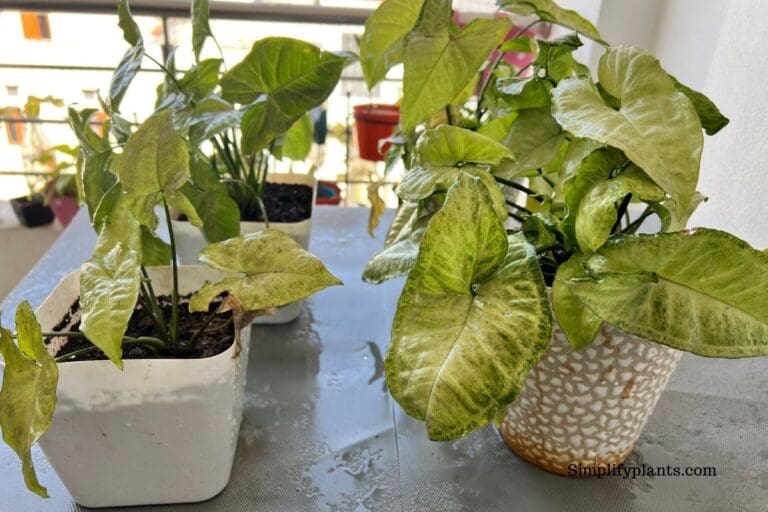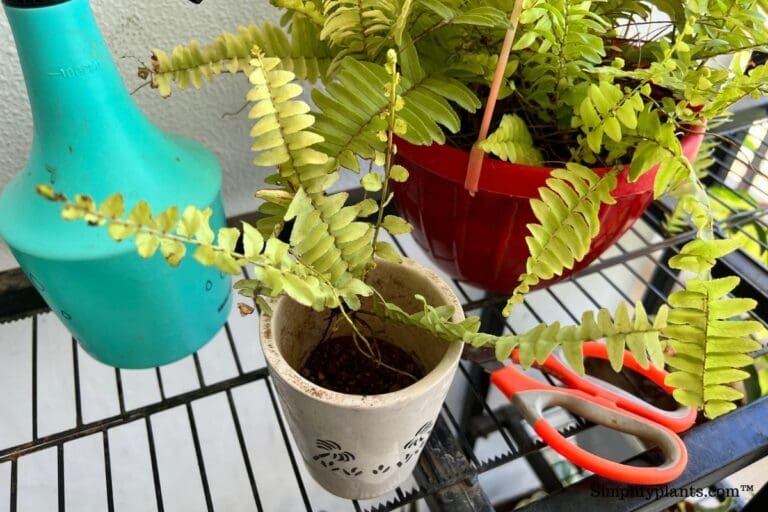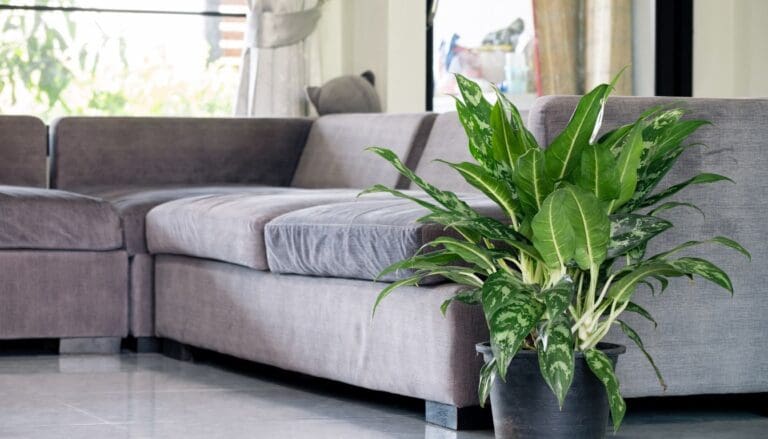8 Reasons Why Your Peace Lily Leaves Are Turning Brown
The peace lily is a tropical evergreen plant originating mainly from the rainforests. If you are in the mood for growing Peace lilies indoors, you need to be aware of the different problems it may face while growing. One of the common problems is brown leaves.
Inadequate watering, over-fertilizing, low humidity, and other irregularities will result in brown leaves in peace lilies. Exposure to direct sunlight can also result in brown spots on the leaves. Provide bright indirect light and water the plant adequately to fix the problem.
Browning of the leaves can occur in different ways. Sometimes, the tips of the leaves get brown, or there are several spots on the leaves, and sometimes, the whole leaves turn brown.
Read this article to understand the reasons for browning in the leaves and the probable solutions to the problem. We will also cover information regarding the prevention of brown leaves.

Please note: Simplify Plants is reader-supported. Some links in the post are affiliate links and I get a commission from purchases made through links in the post.
Different types of brown leaves in peace lilies
Peace lily shows up with different types of browning at different times.
Three types of browning are visible in the Peace lilies- brown tips on the leaves, brown spots on the surface and beneath the leaves, and entirely brown leaves. Let us read in brief.
Brown tips in the leaves
When your leaves start browning, it starts from the tips. Brown tips mean only the tips of the leaves remain brown, whereas the rest of the part is still in good condition.
Causes:
Brown tips in the Peace lilies occur due to poor watering techniques, over-fertilization, light issues, or poor drainage. Some causes are:
- Salt build-up due to poor water quality and over-fertilization cause brown tips.
- Poor drainage system causes brown tips.
- Sometimes, brown tips are expected because the spent flowers and leaves start dying once they get old.
- If your plant receives the scorching heat of the sun, it might result in brown tips.
- Keeping the plant near the heaters or radiators that blow hot and dry air will result in brown tips in the leaves.
- Excessive cold.
Solution:
The first and foremost way to treat the plant is by removing the affected leaves from the plant, so it doesn’t spread much. You need to check the dryness of the soil before each watering constantly and let the soil dry up a bit.
If your soil has accumulated salts, wash the soil well by watering until the salts flush out from the soil.
Do not over-fertilize as a high level of fertilizer can result in necrotic leaf tips. If you are unsure about the number of fertilizers, use less quantity. Make sure to water well after fertilizing.
The soil mix must hold the required moisture and, at the same time, drain excess water. Adding compost will help solve both issues.
Ensure that your peace lily is not receiving the scorching heat of the sun. Move your peace lily away from the window or put a curtain down, making a filter for the direct sunlight.
Keep your peace lily away from heaters and radiators. Remove the spent leaves and flowers from the plant to encourage better growth and make the plant look evergreen.
Brown spots on the leaves
Another common browning issue is brown spots on the leaves.
Causes:
Spots on the leaves can occur due to several reasons. Some reasons are the same as the previous one, and some might vary.
- Watering is a leading cause of the brown spots in the leaves. Both under-watering and overwatering lead to brown spots.
- Light issues can result in brown spots on the leaves. Direct sunlight can lead to sunburn, causing spots.
- Chemical burn due to fertilizers is another reason for the brown spots on the leaves.
- Another important reason for brown spots is pest attacks and diseases, especially several leaf spot diseases that can cause brown spots in the leaves and stems.
Solutions:
To solve the brown spots in your peace lilies, the first thing you need to do is check the watering schedule. If you have overwatered your lilies, avoid watering for some time and let the soil dry up until the next watering. Don’t forget to remove the affected leaves.
Keep the peace lily away from other plants if it is too much affected. Let the plant receive good airflow, but no need to put it under the direct fan.
You can use fungicides and pesticides if they are affected severely by any pests or diseases. Remember, you cannot completely get rid of diseases, but you can suppress them by proper treatment.
Do not let your peace lily receive direct sunlight, and keep it a little away from the window. While keeping near the window, put on the curtains to create a shade for your plant.
While fertilizing, avoid sprinkling fertilizers on the leaves and flowers to avoid burning them, which can cause brown spots.
Entirely brown leaves
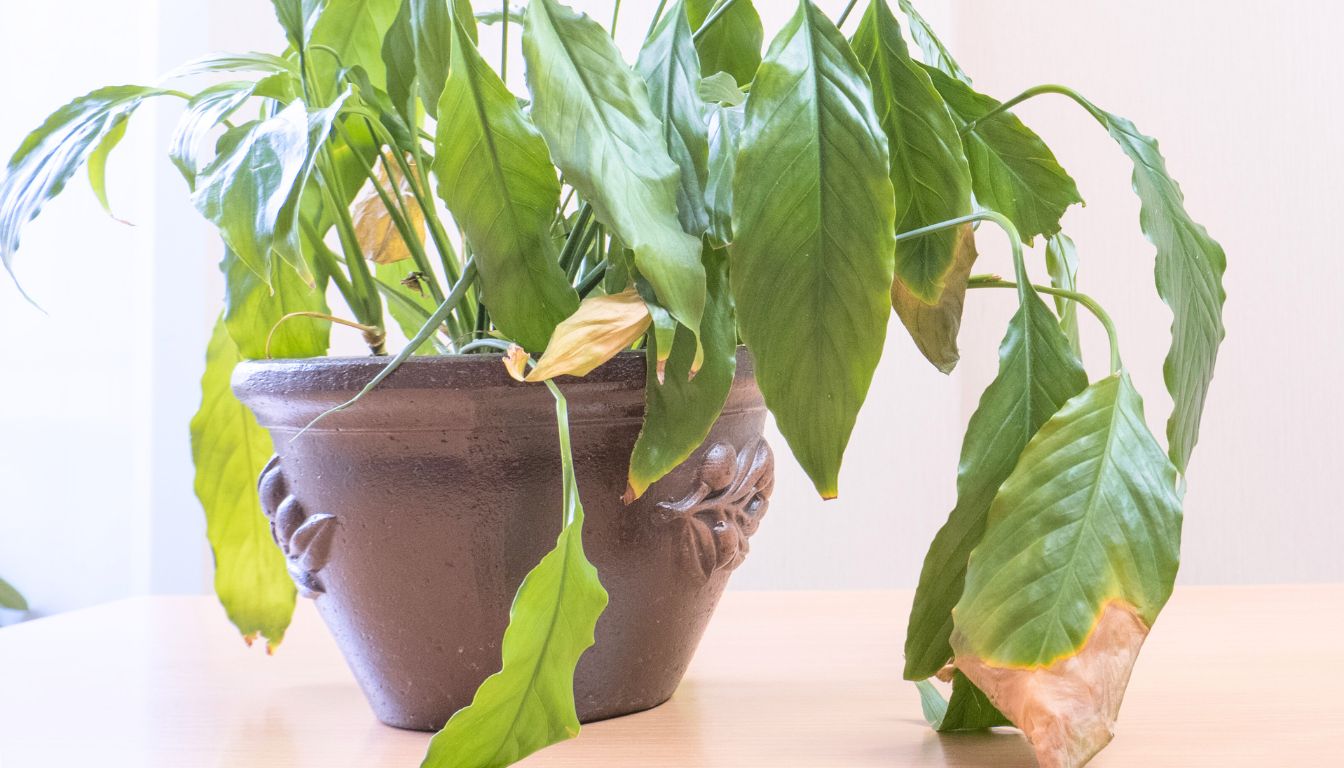
Sometimes, the brown tips and brown spots increase, resulting in complete brown leaves. When the leaves start turning brown completely, it is a sign that something is severely wrong with your Peace Lilies.
Causes:
- Root rot
- Water quality
- Low humidity
- Extreme temperatures
- New environment shock
- Aging
Solutions:
Root rot is one of the severe issues resulting in brown leaves. When you overwater your peace lily, you are suffocating the roots, and they start rotting due to prolonged stay in the water.
To stop this, you need to take out the plant from the pot, remove the affected roots and leaves, and repot the plant in a new pot and soil.
Along with quantity, the water quality too must be checked. Peace lilies need water that is free from harmful substances. Consider using rainwater, melted snow, or distilled water to water your plant. You can also use room temperature or tepid water.
Being tropical plants, peace lilies need humid conditions for good growth. Providing them the exact humidity like their native lands might be impossible, but you need to provide enough humidity for good growth.
Protect your peace lily from extremely high or low temperatures. While growing them indoors, place them where they will not receive any extreme temperatures. Do not place them in the balconies or below any air vent.
Sometimes, the plant starts browning due to new environmental surroundings. You need not worry much about this and give the plant some time to adjust to the new environment.
The leaves get entirely brown due to their completion of the lifecycle. Slowly, after they start browning, they will fall off. This is natural, and there is no solution to it.
Also read: How To Treat Root Rot In Peace Lily? (Signs, Identification & More)
Peace lily leaves turning brown
There are many reasons why the leaves start turning brown, and it is crucial to understand the critical causes of browning on the plant’s leaves.
It will save your time and will help in reviving your plant.
Watering issues

A common problem while growing Peace Lilies is the watering routine.
Both overwatering and under watering create problems for the plant, and they neither like soggy soil nor do they like being in drought.
Overwatering leads to severe problems, starting with brown patches on the leaves, wilting and curling the leaves, and then heading to root rot, pest and fungus infestations, and diseases.
Underwatering causes dry brown patches on the edges of the leaves; the leaves become droopy and limp. The soil will pull away from the side of the pot and becomes compact.
Solutions:
To save your peace lily from overwatering:
- First, to understand if your peace lily is experiencing overwatering, poke your finger into the soil to feel the dampness. If there is any foul smell, it means the plant has root rot.
- To save your plant, first, isolate the plant and remove the affected leaves.
- Take the peace lily out of the pot, get rid of the old soil, and prune the affected roots.
- Repot your peace lily in a new pot with fresh potting soil. If you want to use an old pot, make sure you wash the pot very well and disinfect it. A new soil mix is recommended because the old soil might contain fungus and bacteria due to rot.
- Make sure that both the pot and the soil have a sound drainage system. The soil also must be able to hold enough moisture.
To save your plant from under-watering:
- To understand under watering issue, you can tap the pot, and if you hear any hollow sound, it is because of the dry soil due to less water.
- Watering depends on the size of the plant. Big-sized plants need more water than smaller ones. Water your plant well if you haven’t watered for a long time.
- If you have placed your plant under bright light, frequent watering is necessary.
- Water your plant periodically during the hot summer seasons.
Also read: How Often Should A Peace Lily Be Watered? (Peace Lily Water Requirements)
Ways to check the moisture
Checking the soil’s moisture is the best way to understand whether your peace lily needs watering or not.
You can set your finger into the soil about 2 to 3 inches deep. If the soil is sticky and feels damp, it doesn’t need water. But if the soil doesn’t feel damp and some dry soil attaches to your finger, it needs water.
Another way to check is by lifting the pot. The pot feels heavy means it doesn’t need water. Wait to water until the soil dries up.
Water quality

Only following the proper watering schedule will not solve the brown leaf problem. Along with quantity, a quality check is also necessary.
They need water free of harmful substances. Depending on your living area, the water might contain adverse chemicals like chlorine and fluorine.
These start accumulating in the transpiration paths of the plant. The stomata and leaf margins result in brown leaves or difficulty in photosynthesis.
Solutions:
- If you find signs of poor water quality, stop using the usual water you do.
- Remove the affected leaves, if any.
- Stop using tap water.
- Start using rainwater or distilled water.
- You can even use filtered water.
- Use room temperature water for good results. Avoid using too hot or cold water.
Light exposure
Being indoor plants doesn’t mean that peace lilies do not need light. But they do not like too much light either. They need indirect sunlight for growth.
Inadequate light or excessive light can cause various problems:
- Sunburn
- Dry brown spots
- Bleached leaves
- No blooms
- Leggy peace lilies
Solutions:
- The first thing to do is place the peace lily in a bright place but away from the direct rays of the sun. If you have accidentally exposed them to direct sun, remove the plant immediately or pull down the curtains. Place your plant in the south or west-facing windows.
- If you lack sunlight for a couple of days, which can happen during the monsoon, you can grow your peace lilies under artificial lights. Place the light about 6-12 inches above the tallest part of the lilies. Use cool white lights. Let the light on for 12 to 14 hours. Make it 16 to 18 hours if it is not getting any additional lights.
- If your peace lily gets scorched due to too much light, get rid of the affected parts. This will help to save energy and focus on growing the good ones than the wasted ones.
Also read: What Kind Of Light Does A Peace Lily Need? (Peace Lily Light Requirements)
Temperature issues
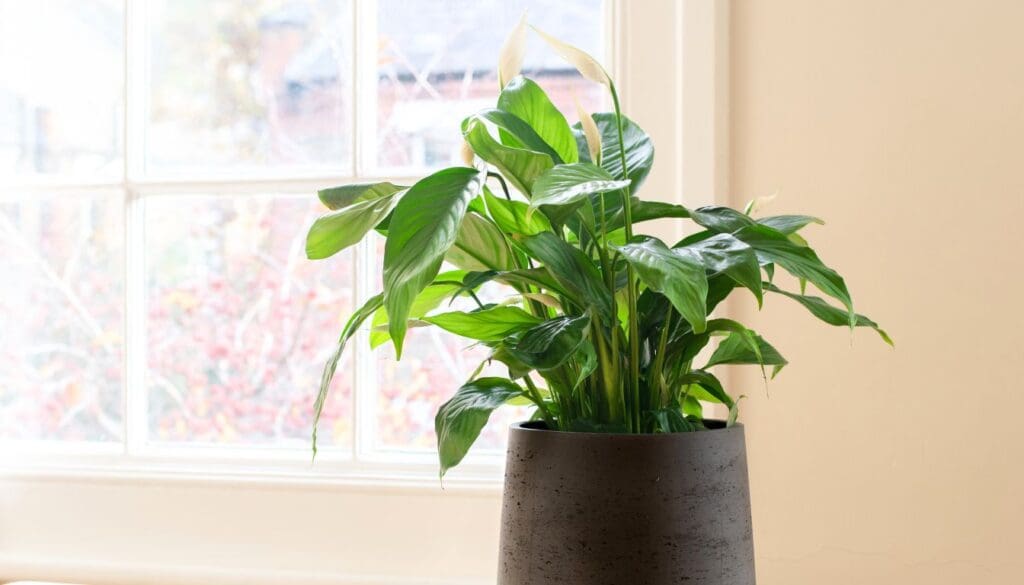
Peace lilies require temperatures ranging between 65-75°F during the day and a fall of 10°F during the night.
But temperature fluctuations can cause the following.
- Very high temperatures will cause malfunctioning, significantly increasing respiration in the plant.
- Low temperature will lead to frost injury. It will damage the tissues of the plant and prohibit photosynthesis.
- Other problems are wilting and curling of the leaves, along with browning at the tips.
Solutions:
- While placing the peace lily indoors, you need to check whether the plant is placed in a spot where the temperature can change rapidly, near the windows and the doors. It is good during the summers but drafty during winters.
- Prevent hot air around the plant by venting air out.
- Use a cooler to increase the coldness of the place.
- Avoid keeping the plant in the balconies.
Humidity issues
Belonging to the tropical rainforest regions, they need high humidity to thrive well.
Low humidity will cause:
- Wilted leaves
- Brown leaves
- Leaf curl
- Leaves become crispy
Solutions:
Providing high humidity indoors is impossible, and it will be uncomfortable for us to handle. They need to get at least 25% to 49% humidity to survive.
- Mist the peace lily regularly. During hot summers, they need more misting.
- Let it sit in a pebble tray. Evaporation will give them more moisture.
- Install a humidifier in the room where the peace lily is placed. It will help them receive the humid environment of the rainforest region.
Also read: Do Peace Lilies Need Misting? (+Ideal Humidity)
Pest infestations

Pests like mealy bugs, spider mites, aphids, and scales suck all the saps from the leaves, leaving them lifeless. They make the leaves distorted, resulting in discoloration, including brown spots on the leaves.
Solutions:
- Firstly, isolate the plant to avoid spreading the pests to other plants.
- Remove the affected leaves.
- Remove the pests with your hands (wear gloves) by handpicking them.
- Use cotton and alcohol to wipe off the insects with your hands.
- Give your plant an excellent forceful wash, but do not increase the force as it may damage the plant.
- Use soap water to remove the insects. After applying soap water, rinse the plant with water.
- Use insecticides if the problem is severe.
Also read: Do Peace Lily Attract Bugs? (Identification+How ToGet Rid Of Them)
Diseases
If you notice any browning in the plant’s leaves, it might be due to some diseases caused by fungus or breeding pathogens. These either arrive due to damp conditions or come from outside factors like rain or wind.
Some diseases are Cylindrocladium root and petiole rot, Alternaria Leaf Spot, and Bacterial Leaf Spot.
All these lead to various problems.
- Brown spots with yellow haloes.
- Irregular small brown spots.
- Distortion of the leaves.
- Water-soaked areas eventually turn to irregular brown spots on the leaves.
- Brown spots turn to black lesions.
- Droopy leaves.
- Decaying roots.
Solutions:
- Isolate the plant and remove the infected parts using a disinfected scissor or pruner.
- Apply fungicides to reduce the damage.
- Discard the extremely damaged parts.
- Avoid overwatering.
How to remove the dead leaves from peace lily?
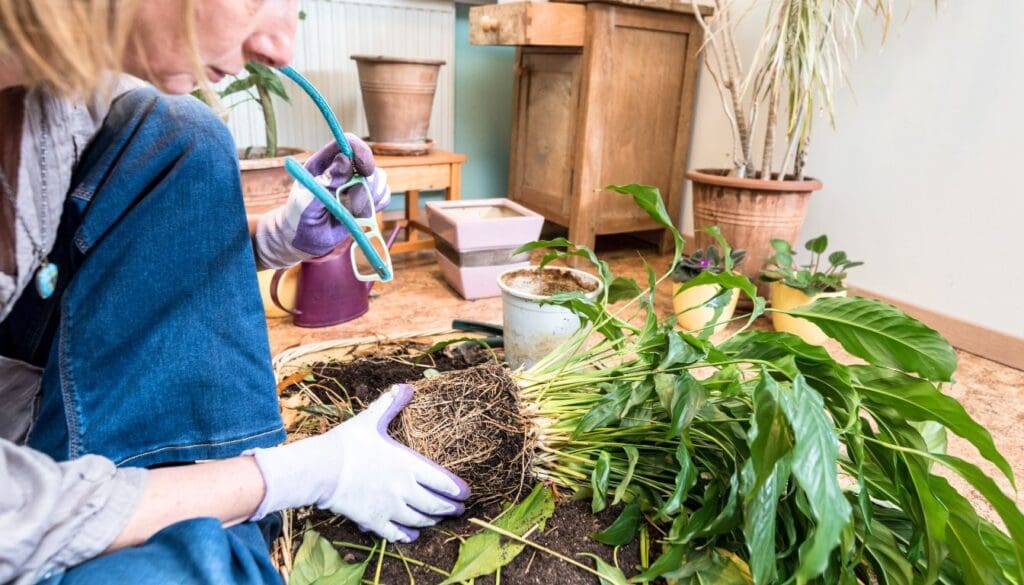
The most important part before you start treating your plant is getting rid of the dead and infected leaves from the plant.
Use a sterilized scissor or pruner for pruning because you don’t want to spread any bacteria from the scissor to the plant.
If there are brown spots in the leaves or the entire leaf is brown, get rid of the leaves. Cut the stem so that the plant can grow new leaves. Pruning improves and stimulates the growth hormone of the plant.
How to prevent brown leaves on peace lilies?
- Provide them indirect sunlight and sufficient light.
- Prepare them for hot and cold days. Place them indoors and away from windows during cold nights. Keep them away from drafty spots to avoid shock and stress.
- Adjust watering techniques according to the weather and season changes.
- Check your peace lily regularly for any infestations.
- Prune the affected parts if you notice them.
- Use a healthy soil mix for your peace lily. It should have a sound drainage system and the ability to hold adequate moisture. Also, the pot you are using should have drainage holes.
- Give them good fertilizers. Use a balanced fertilizer (20:20:20) for good results. If in doubt, you can use less fertilizer. While using granular fertilizers, avoid sprinkling on the flowers and leaves to avoid burning.
A quick tip: Sometimes, browning is natural. The dead and spent flowers and leaves that have completed their lifecycle eventually fall off, and you cannot do anything with those brown leaves.
Take good care of your peace lily. Observe it regularly and check the plant closed before buying to understand if there is any problem.
Recommended Garden Supplies
| Product Image | Our Recommended Gardening Supplies | Check Offers! |
|---|---|---|
Top Top
Top
Top
Top
Top
Top
Top
Top | rePotme Houseplant and Tropical Classic Potting Soil Mix | Check Offer On Amazon |
 Top
Top
Top
Top
Top
Top
Top
Top | Espoma Organic Indoor Plant Food | Check Offer On Amazon |
 Top
Top
Top
Top
Top
Top
Top
Top | GooingTop LED Grow Light 6000K Full Spectrum Clip Plant Growing Lamp | Check Offer On Amazon |
 Top
Top
Top
Top
Top
Top
Top
Top | Soil Moisture Meter | Check Offer On Amazon |
 Top
Top
Top
Top
Top
Top
Top
Top | Govee Hygrometer Thermometer, Bluetooth Enabled! | Check Offer On Amazon |
 Top
Top | LEVOIT Humidifiers for Large Room(Best For Plants) | Check Offer On Amazon |
 Top
Top
Top
Top
Top
Top
Top
Top | Upgraded DIY Automatic Drip Irrigation Kit, 15 Potted Houseplants Support | Check Offer On Amazon |
 Top
Top
Top
Top
Top
Top
Top
Top | Stainless Steel Heavy Duty Gardening Tool Set | Check Offer On Amazon |
 Top
Top
Top
Top
Top
Top
Top
Top | Bonide Insecticidal Soap | Check Offer On Amazon |
 Top
Top
Top
Top
Top
Top
Top
Top | Bonide 32 oz Spray Neem Oil for Organic Gardening | Check Offer On Amazon |
 Top
Top
Top
Top
Top
Top
Top
Top | Garden Safe Fungicide | Check Offer On Amazon |


